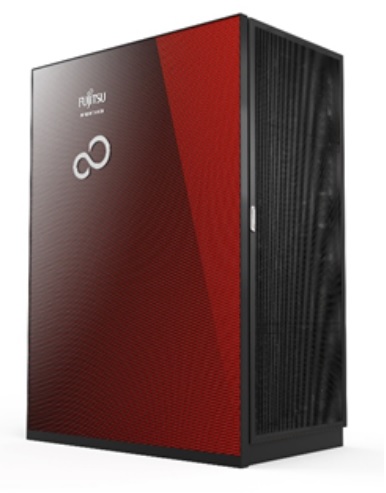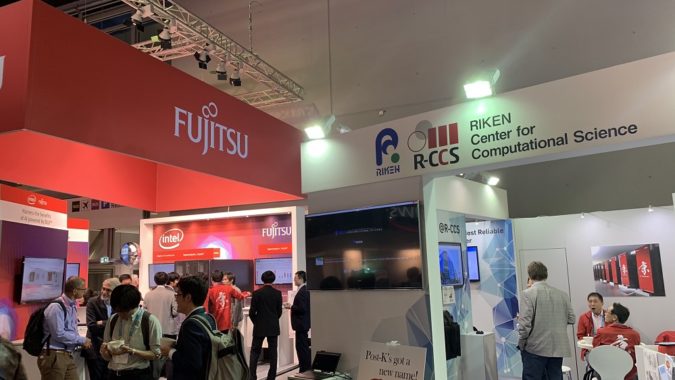The number of top-tier HPC systems makers has shrunk due to a steady march of M&A activity, but there is increased diversity and choice of processing components with Intel Xeon, AMD Epyc, IBM Power, and Arm server chips all in the mix (and that’s just on the CPU side). A partnership announced today between Cray (now part of HPE) and Japanese IT giant Fujitsu is indicative of this trend and of a growing interest among leading HPC sites to field architecturally diverse systems that can serve double duty for simulation and AI processing.
 The duo announced a partnership that will have Cray developing a commercial supercomputer powered by the Fujitsu A64FX Arm-based processor — that is of course the same chip going into the post-K “Fugaku” supercomputer to be deployed at RIKEN in 2021.
The duo announced a partnership that will have Cray developing a commercial supercomputer powered by the Fujitsu A64FX Arm-based processor — that is of course the same chip going into the post-K “Fugaku” supercomputer to be deployed at RIKEN in 2021.
The new HPE-Cray system, part of the Cray CS500 lineup, will employ the Fujitsu A64FX Arm-based processor with Arm Scalable Vector Extensions (SVE) and second-generation high-bandwidth memory (HBM). Named as customers in today’s release are Los Alamos National Laboratory, Oak Ridge National Laboratory, RIKEN Center for Computational Science, Stony Brook University, and University of Bristol. Cray and Fujitsu said they will be exploring engineering collaboration, co-development, and joint go-to-market strategies to meet customer demand as supercomputing extends into the exascale era.

“Our partnership with Fujitsu means customers now have a broader choice of processor technology to address their pressing computational needs,” said Fred Kohout, senior vice president and CMO at Cray. “We are delivering the development-to-deployment experience customers have come to expect from Cray, including exploratory development to the Cray Programming Environment (CPE) for Arm processors to optimize performance and scalability with additional support for Scalable Vector Extensions and high bandwidth memory.”
HBM2 on A64FX provides a maximum theoretical memory bandwidth greater than 1 terabyte per second (TB/s), a significant increase over DDR4, according to the companies.
“It’s a pleasure to partner with Cray on building technologies for the next era of computing,” said Takeshi Horie, corporate executive officer, vice head of service Platform Business Group at Fujitsu. “Both companies have a strong legacy of supercomputing and vector processing. The A64FX Arm processor was designed to empower a wide range of data-intensive applications and is the world’s first CPU to adopt the SVE of the Armv8-A instruction set architecture, specifically extended for supercomputers.”

A few hours after the joint Cray-Fujitsu announcement was made, Fujitsu launched its own A64FX machines, the PRIMEHPC FX1000 and PRIMEHPC FX700 models that will employ the technology developed by RIKEN and Fujitsu for the Fugaku supercomputer.
As with the new Cray offering, the “Fujitsu Supercomputer PRIMEHPC” series will be equipped with the A64FX chip with Scalable Vector Extension (SVE), an extension of the Armv8-A architecture for supercomputers. “The CPU not only achieves a high memory bandwidth by using HBM2, a high-performance die-stacked memory, but also can handle half-precision arithmetic and multiply-add, which are important in such technologies as deep learning. In this way, the new supercomputers are expected to expand its use in the field of AI,” said Fujitsu.
For customers inside Japan, FX1000 deployments start at a minimum of 48 nodes, FX700 starts at a minimum of two nodes; for countries outside Japan, the entry point for FX1000 is 192 nodes and FX700 starts at a minimum of 128 nodes.
 In a management direction briefing held in September, Fujitsu shared strategy for selling the new systems. “They are not being offered as stand-alone hardware, but alongside services, and we hope that they will be used in a variety of fields. At the same time, we introduced these products with the understanding that competing with just stand-alone hardware makes for an extremely difficult business environment,” said Takahito Tokita, President and Representative Director at Fujitsu Ltd.
In a management direction briefing held in September, Fujitsu shared strategy for selling the new systems. “They are not being offered as stand-alone hardware, but alongside services, and we hope that they will be used in a variety of fields. At the same time, we introduced these products with the understanding that competing with just stand-alone hardware makes for an extremely difficult business environment,” said Takahito Tokita, President and Representative Director at Fujitsu Ltd.
Fujitsu will be presenting on its PRIMEHPC FX Series architecture at SC19 on Thursday, Nov. 21 (link).
Cray’s A64FX-powered CS500 system is scheduled to debut mid-2020; while Fujitsu says its new systems will start shipping in March 2020. It makes sense that Fujitsu would have a bit of a head start, but we’ll see. Fujitsu has not disclosed any customer wins yet (outside of Riken/Fugaku, of course, the flagship custom system), while Cray has four customers on record.
Among the first to purchase a Cray-Fujitsu system is Stony Brook University. Ookami, Japanese for wolf, is a $5 million testbed project funded by the NSF and conducted in collaboration with RIKEN CCS in Japan. “Memory-bandwidth-intensive applications will be especially accelerated by the ultra high-bandwidth memory while still being able to employ familiar and successful multi-core programming models,” said Robert Harrison, principal investigator and project director for Stony Brook University.
Oak Ridge National Laboratory, future home of Frontier (the Cray-AMD exascale system), is another early customer. Jeff Nichols, associate lab director for computing and computational sciences at Oak Ridge National Laboratory, commented that access “will enable our scientists to experiment with possible system architectures for the Exascale Era and advance the DOE mission.”
Los Alamos National Laboratory will also be testing out the new architecture. “The most demanding computing work at LANL involves sparse, irregular, multi-physics, multi-link-scale, highly resolved, long-running 3D simulations. There are few existing architectures that currently serve this workload well. We are excited to see a potential solution and are happy to be helping prove this Cray and Fujitsu technology is a viable alternative for this need. Having this type of capability will be quite complementary to other resources in the NNSA computing complex,” said Gary Grider, deputy division leader, HPC Division at Los Alamos.
In the UK, the University of Bristol, an early pioneer and proponent of Arm64 for HPC, is planning to build Isambard 2 on the Cray-Fujitsu architecture. Simon McIntosh-Smith, professor of high-performance computing at the University of Bristol and winner of the 2018 HPCwire Readers’ Choice Award for leadership, said his group expects to make these new technologies available to UK scientists later in 2020.
More Choices…
Globally, HPC efforts are increasingly reaching beyond traditional x86 suppliers to meet their computing requirements, spurred by the twin mandates of maintaining technological leadership and protecting national interests. The European Processor Initiative, which prioritizes technological self-reliance for the EU, is developing custom chips using Arm, RISC-V and FPGAs. RIKEN, of course, is working to field Fugaku in 2021, using primarily Japanese technologies. China has multiple homegrown technologies powering its largest supercomputers.
In the U.S., the next batch of leadership-class systems (going by current disclosures) will employ technologies from Cray/HPE, Intel, AMD, Nvidia and Mellanox. Sandia National Laboratories fielded the world’s first petascale Arm supercomputer, Astra, powered by Marvell/Cavium ThunderX2 processors in an HPE system. And the Tri-Lab Vanguard project was initiated to explore and develop Arm technologies for Sandia in partnership with Lawrence Livermore National Laboratory and Los Alamos National Lab.
At ISC in June, Nvidia announced it would be ramping up support for accelerated-ARM (Arm+GPUs) to a chorus of endorsements from Cray, Marvell, RIKEN and others. We expect updates from all the relevant players at SC19.
There is also growing interest in the vector architecture of another Japanese company, NEC. Los Alamos National Laboratory and the United States Naval Research Laboratory are both presenting on early work and benchmarking of the NEC SX-Aurora TSUBASA Vector Engine at NEC’s Aurora Forum, to be held at SC19 on Monday, Nov. 18 (link).



























































